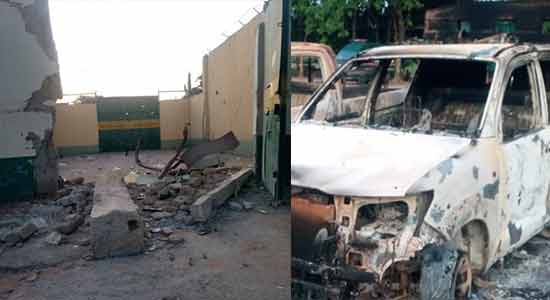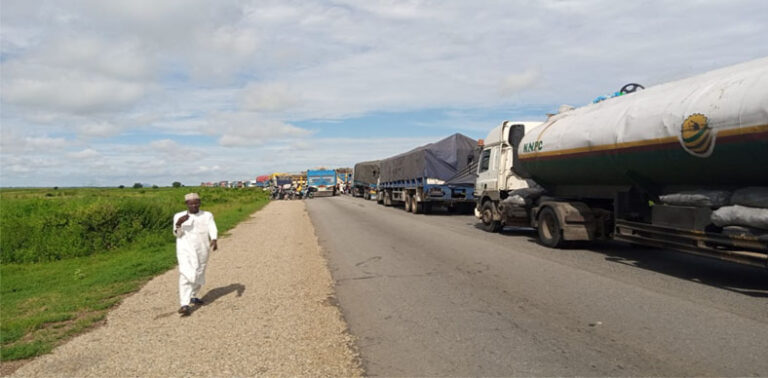
The first, second and third bomb explosions from the Boko Haram terrorists last Tuesday night may have caught the residents of Kuje Area Council napping.
Consequently, many of them were thrown into panic and confusion. But the successful attack on the Kuje Medium Correctional Centre did not certainly come as a surprise to visitors, workers and close residents of the facility.
Fully armed to the teeth, the daredevil Boko Haram insurgents numbering over 300 came fully prepared with bombs, grenades, and all manner of high-calibre ammunition just on a single mission to free their commanders and other members held in the detention facility.
The seamless manner, the clinical execution and insignificant casualties recorded on their part were confirmations that they took their time to perfect and execute the operations with faultless intelligence.
It was not an operation carried out in a haste, as available information revealed that they inhabited freely with the residents, and rented houses near the prison facility, for several months or even up to a year.
As part of their efforts to perfect their planned operation, many of them were said to have disguised themselves, operating as commercial motorcyclists, private security men, traders, and labourers, among other menial jobs, that facilitated their easy blend, especially in the Mosques, markets, and homes with other innocent residents of Kuje.
While the plot lasted, they did not leave any trace that could give them away apart from their excessive consumption of Indian hemp, occasional display of aggression and periodic strategic meetings.
However, as they carry on their clandestine activities, intelligence reports were either weak, not acted upon or totally ignored. The synergy among the security agencies continued to widen to the point that a security report confirming the attack, on the eve, was deliberately or casually overlooked.
Exploiting the weak intelligence, the insurgents had continued to get emboldened by the day, including smoking weeds very close to the back of the prison wall unchallenged and mingling with the security guards during prayers, until the intimidating gang, numbering over 300, successfully carried out the operation with expectedly feeble resistance from the security forces, who may be relatively very new to their duty post.
With the operation successfully carried out in a show of superior force and celebrated in carnival-like mood with soft drinks littering everywhere, human and material loses of an unimaginable magnitude were incurred.
In counting the losses, the prison wall had fallen, inmates, numbering over 1,000 escaped, sensitive and non-sensitive documents were either burnt or carted away and more importantly, the insurgent commanders were freed from captivity to worsen and escalate the war against the enemies of the country.
But, in reality, activities at the Kuje Medium Correctional Centre, to close residents, regular visitors, staff and even the security guards, rightly depict the explosion of the time bomb that has been building up to go off at the planned time.
Apparently, security lapses were evidenced in many ways. There was no regular power supply to light up inside and outside the facility.
According to a Correctional Service staff, the challenging power situation was so bad that inmates had to resort to the use of rechargeable lanterns for light.
“Beyond overpopulating the prison by majorly awaiting trial inmates without conscious efforts to decongest the population, the absence of any Close-Circuit Cameras to monitor activities within and outside the prison yard was another challenge of serious concern. There was no perimeter fencing to ward off intruders, which aided the attackers to easily seize the centre,” the staff lamented.
The source added: “For those that care to know, Kuje Medium Prison is one of the freest facilities in the world. It is so because there has always been an influx of international human rights organisations into the prison. With that development, there is a limit to which the prison authorities can deny the inmates exercise of some fundamental human rights.
“Perhaps, that might have accounted for the reason many high profile inmates were allowed the use of phones. Let me shock you that there is one particular Boko Haram commander inside the prison that knows about virtually all the attacks they want to carry out in any part of the country, even as an inmate. He looks so intimidating with the heavy muscles he had continued to build inside the prison.
“The porosity of the prison accounted for why the authorities rejected the appeal to bring Nnamdi Kanu back to the prison again when he was rearrested. I can tell you that the prison cannot avoid experiencing the horrible incidences it had when Kanu was there before.
“The inmates were sharply divided along ethnic lines. The atmosphere was always charged because the inmates pledged their loyalties to their ethnic leaders like Kanu and the Boko Haram commanders. I cannot forget in a hurry the day deadly clash was averted inside the prison.
“It was obvious that the loyalists to the Boko Haram leaders were tired of the harassment from those loyal to Kanu that always want to clear the road. Unfortunately for Kanu loyalists, they tried it when the Boko Haram commanders who were outside, but they refused to leave the road.
“They threatened to burn down the prison and kill Kanu. The warders on duty begged both sides, but none was ready to bulge. Those in-charge were involved and it took more than 30 minutes to restore calm. After the incident, the prison had peace of the graveyard until Kanu finally left. It was that ugly experience that made the authorities resist any plan to bring Kanu back to this centre.”
How the terrorists struck
Like the divergent views in the description of an elephant, different accounts have trailed the modus operandi the insurgents adopted in attacking the Correctional Centre with the popular account being that they struck through the back gaining confirmation from the authorities.
Some of those whose houses are few metres away from the prison confirmed to our correspondents that the attackers came from the riverside behind the prison; while others claimed they attacked from the front.
However, a prison staff, in an official account argued that they deployed a three-pronged attack.
It was further gathered that the terrorists had gathered, in clusters in surrounding villages, on the eve of the attack to perfect their movement on D-day.
Though the villagers in the communities raised the alarm over the presence of strange persons in their vicinity, to the police and security agencies, not much was done to curtail the movement of these strangers until the attack on Tuesday night.
“What I can tell you for sure is that they knew that if they had escaped through the road, they would have been intercepted by the security forces. The truth is that they were more proactive to choose and study an escape route through the bush path. They came through there and left through the same route. It was a bush path they have used severally without sending a negative signal to the villagers on what their real mission was,” the prison officer told Sunday Sun.
Porosity
Security sources described the location of the Kuje prison as very porous and prone to attacks by anybody.
“As a prison where hardened criminals are kept, not much was done to secure the place from attacks. Even the walls are made of blocks instead of casting.
“Unfortunately, the facility does not have a buffer and a second wall as part of security measures to make it difficult for criminals to gain access. At the back of the prison is a vast expanse of land that is not properly monitored, which made it very easy for the attackers to gain access into the building.
“The terrorists had planted four explosives at different spots around the prison that went off one after the other. With the blasts that sent a warning signal and scared the security guards, they were able to go in with other dangerous weapons to free their colleagues and escaped without much resistance from the soldiers who had just been rotated a few hours before the attack.
“While the attack was going on, the soldiers, about 33, in number could not do much to return fire for fire using their AK47 riffles, while the terrorists came prepared with General Purpose Machine Gun (GPMG), and other sophisticated weapons.
“The soldiers who had barely accustomed themselves with the vicinity of the prison were so confused that they forgot that they had an Armour Personnel Carrier (APC), mounted in front of the prison. However, two of the terrorists were killed by the soldiers who also went after the terrorists in the bush. Their decision to raid the forests in the FCT, yielded positive results as some escapees were rearrested and returned to the facility.
“Although security operatives comprising the military, police, DSS, and the paramilitary agencies were drafted to the scene of the attack Tuesday night, a detachment of helicopters from the Nigerian Air Force, began patrolling the airspace Wednesday morning,” a top security source told Sunday Sun.
In another account, some security personnel always on duty at the Kuje prison for some time now, described the location of the facility as very dangerous and prone to attacks.
He said that apart from residents encroaching dangerously close to the facility, the Medium Correctional Centre is surrounded by bushes that stretched to Shiroro in Niger State and other dangerous locations housing bandits, terrorists and criminal groups.
The source, who does not want to be mentioned in print, said that the facility is not fit to detain rapists and pickpockets let alone hardened criminals like terrorists, bandits and their likes.
While emphasising that the facility is poorly built, our source said that the government were not proactive in upgrading the facility to accommodate the criminals.
“For instance, the prison walls that ordinarily should be done with cast and a buffer were not considered by those who built the place knowing full well that it is a prison facility.
“Rather than spending money to upgrade the facility to a string and lasting wall for protection from attacks, the contractors under the supervision of government, used blocks like every other house owner to build the walls, which made it very easy for the attack to blow off the fence,” our source explained.
Security collaboration conspiracy theory
Regardless of how they carried out the successful operation, the suspicion of the involvement of security agents has understandably persisted.
A prison officer, in attesting to it, confided in our correspondent that despite the Armour Personnel Carrier (APC), and submachine gun at the disposal of the security agents on guard, there was no single attempt to deploy the weapon to use.
“The terrorists that came for the operation did not touch the APC and the submachine guns, yet they burnt down the official and personal cars beside them. There was no single resistance from the security forces on ground to confront the attackers.
“Despite the numbers of the combined security guards, comprising the army, police, Civil Defence and our own armed squad, none of them was courageous enough to curtail the terrorists. In fact, the Civil Defence personnel who lost his life was the only one who tried to display gallantry, but he paid with his life because he could not understand why the army and mobile policemen withdrew, or listened when his colleague warned him to go into hiding. The response rate from the security guards was not encouraging at all.
“Inside the prison was completely empty in the morning hours because virtually all the inmates escaped. From what I gathered, one of the terrorists even broke into the office where sensitive files are kept and either destroyed or burnt them not to trace any record about them. I also gathered that they made attempt to break into Abba Kyari’s cell, but it was difficult for him,” he explained.
But, the Minister of Defence, Bashir Salihi Magashi, while confirming that the terrorists were on a mission to free their commanders mainly Boko Haram members, said that they succeeded in evacuating 64 Boko Haram members inside the detention camp, but however, dismissed the insinuations and conspiracy theory in the involvement of the security agents.
“The people that came for this operation, from available records are believed to be from a particular group and most likely they are Boko Haram members. This is because we have a sizable number of Boko Haram members in detention at Kuje prison, but presently we could not locate any of them. The number of Boko Haram inmates is about 64 and none of them is in prison again. They have all escaped,” he revealed.
On why the army responded too late and equally failed to act on the security report, the Defence Minister said: “If people give timely intelligence at the right time, I am sure we will react promptly. But when it is not coming on time you don’t expect us to react. There is every likelihood that the situation is going to be interpreted on the basis of being quick or slow in responding to intelligence.
“From our discussion, I am sure that every security agent that came to Kuje Prison participated in every way possible to ensure that the prisoners did not escape. There was reinforcement because the Brigade of Guards was fully in charge. Our happiness is that many of them have been recaptured.”
Misuse of purpose
The 33-year-old detention facility, built and commissioned on August 14, 1989 and rated as one of the best in Northern Nigeria with a potential 560 capacity inmates, was meant to keep pro-democracy activist prisoners from the southern part of Nigeria.
However, due to the resurgence in crime and criminalities, the prison had deviated from the initial purpose it was meant to serve, and started accommodating hardened criminals, bandits and terrorists.
Reacting to the situation in Kuje Prison, Retired Deputy Controller of Prison, Simon Dung, in a chat with our correspondent, lamented that Kuje prison only recently developed a negative reputation as a detention centre for high profile criminals like Boko Haram terrorists.
“May I remind you that Kuje Prison was actually a facility financed by the military to keep pro-democracy agitators? One of the groups involved in the campaign to end military rule in Nigeria was Campaign for Democracy (CD), which is a pro-democracy coalition of human rights, women’s, workers, and student groups. Pro-democracy activists arrested for whatever reason across Nigeria were sent to Kuje prison.
“At that time, crimes of terrorism of this dangerous sort have not reared their ugly heads. And one couldn’t think of this kind of jailbreak happening during those days. So, part of the reasons for laxity on the side of the government is that most of those who have ruled Nigeria since 1990s are from the military with little or no preparation for occasions of this kind.
“What you see is a security tower, built to be manned by a sentry and possibly private soldier in those days while guiding pro-democracy agitators who were mostly academics and women, different cases from the kind of crimes and criminality experienced today.
“I am also aware that there has not been any major renovation or remodelling of the facility to make it sophisticated to stand the 21st Century security challenges.
“So, as you can see the reason for setting up Kuje Prison was political and not crime. And what would have been of immense priority was to redesign the prison after it started housing high profile criminals like a proscribed terrorist group, Boko Haram,” he noted.
Residents react
For every resident of Kuje, the unimaginable escape of the terrorists has thrown them into heightened apprehension and confusion.
It has worsened the already insecure cases of marauding kidnappers and robbers ravaging the area council.
“To think that we have mingled with members of the deadly Boko Haram sect in our midst for that long is traumatic enough for every resident of Kuje. Come to think of it that they have known the terrain very well having been involved in Okada operation, which took them close to our house even made our situation more terrifying,” a resident, who declined his name for security reasons, lamented.
Another respondent, a commercial motorcycle operator, who identified himself as Magaji Wahab from Kebbi State, innocently blamed the attack on security lapses.
“You see, sometimes the military will claim that they know security well. But, I can tell you that most of these boys came in and infiltrated the community months before the operation. As I do this work, I have seen many things, but my own is to collect my small money to feed my family.
“So, before it happened many of them were operating Okada and that is why on the day of the attack, scores of terrorists stormed the location with motorcycles and detonated improvised explosive devices (IEDs) and grenades.
“Last Tuesday, was the most fearful night of my life because even though we saw some of those boys when they entered the town and could not inform police or army for fear of using me as an example, it was shocking that the security agencies could not curtail the attack.”
Mary Simon Bako, a widow, residing right behind the prison facility told Sunday Sun that she and her family witnessed unusual movements from fierce-looking men sitting close to the bush consuming India hemp endlessly.
“When we saw them, we felt something unusual, but it did not occur to us that it was going to be this kind of war-like situation. You see, since seeing boys smoking weed in and around Kuje has now become a daily thing, we felt it was as such,” she narrated.
Reacting further, Bako described the sounds from the bomb explosives as deafening, adding that the several gunshots during the attack should be enough to kill all the security men around the facility.
The widow admitted that all have not been the same for her household since the attack, lamenting that the situation has affected her income because security agents now comb her compound every now and then with strict instruction not to either move about at odd hours or stay out beyond 3:00p.m.
“Can anyone tell me how I can cope with this kind of situation? I feed and pay school fees from this business and we stay late into the night while dealing with customers,” she said.
Sani Gorah, another resident of Kuje, in a shocking revelation, narrated how he housed military men that took cover in his residence.
“I slept under my bed; the military men on the road entered my house. They dived under my bed and said they were the target. According to them, they have better guns than that of the military which is AK 47,” he said.
Sani further explained that bullets nearly hit his brother, Hassan, who was coming home from town.
“The operation lasted from around 10:00p.m to 12 midnight with no military presence to stop them. I can tell you this because the shooting continued unabated.
“It was at that point we understood that those boys we saw previously meant bad. I think I have learnt my lessons about this community. Today, I understand that the prison yard is a security threatening environment,” he quipped. (Sunday Sun)







